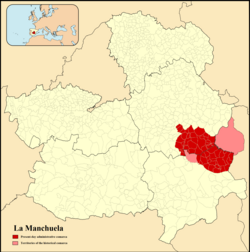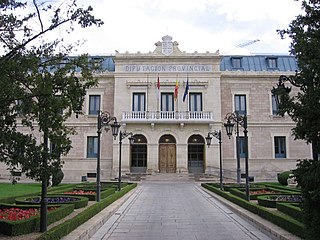
Cuenca is one of the five provinces of the autonomous community of Castilla-La Mancha. It is located in the eastern part of this autonomous community and covers 17,141 square km. It has a population of 203,841 inhabitants -- the least populated of the five provinces. Its capital city is also called Cuenca.

La Mancha is a natural and historical region located in the Spanish provinces of Albacete, Cuenca, Ciudad Real and Toledo. La Mancha is an arid but fertile plateau that stretches from the mountains of Toledo to the western spurs of the hills of Cuenca, and bordered to the south by the Sierra Morena and to the north by the Alcarria region. La Mancha includes portions of the modern provinces of Cuenca, Toledo, and Albacete, and most of the Ciudad Real province. La Mancha historical comarca constitutes the southern portion of Castilla-La Mancha autonomous community and makes up most of the present-day administrative region.

In Spain traditionally and historically, some autonomous communities are also divided into comarcas.

Los Serranos is a comarca in the province of Valencia, Valencian Community, Spain. It is part of the Spanish-speaking area in the Valencian Community.
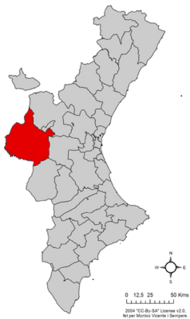
Requena-Utiel is a comarca currently in the province of Valencia, Valencian Community, Spain. Historically, the comarca was part of Castile and formed part of the province of Cuenca in the 1833 provincial division of Javier de Burgos. As such, its inhabitants have been traditionally monolingual in Spanish and not Valencian- speakers. However, in 1851 it was merged into the province of Valencia, as a result of its commercial ties with the city of Valencia.

Bobal is a variety of Vitis vinifera, a red grape used in winemaking. It is native to the Utiel-Requena region in Valencia, Spain. The presence of Bobal in Utiel-Requena was documented in the 15th century in "Espill o llibre de les dones” by Jaume Roig. The name derives from the Latin bovale, in reference to the shape of a bull’s head.
Utiel is a municipality in the comarca of Requena-Utiel in the Valencian Community, Spain.
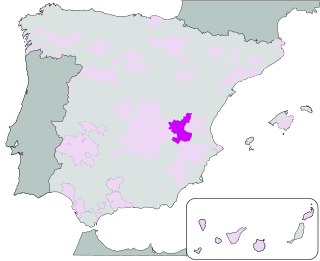
Manchuela is a Spanish Denominación de Origen Protegida (DOP) for wines located in the historical Manchuela comarca, in the east of the provinces of Albacete and Cuenca between the valleys of the Rivers Júcar and Cabriel. It was originally part of a much larger La Mancha DOP and became a separate DOP in 2004. It is surrounded on three sides by other DOPs: La Mancha to the west, Utiel-Requena to the east and Jumilla to the south.

Utiel Requena is a Spanish Denominación de Origen Protegida (DOP) for wines located in the province of Valencia. It takes its name from the two neighbouring towns of Utiel and Requena. It is renowned for the predominant use of the Bobal grape variety.
Villanueva de la Jara, popularly called La Jara, is a town and municipality in the Manchuela Conquense comarca, this in turn is part of the La Manchuela comarca, province of Cuenca, in Castile-La Mancha, Spain. It is known for the cultivation of portobellos and other edible fungi which is the main economic activity of the locality.

Iniesta is a municipality located in the province of Cuenca, Castile-La Mancha, Spain. According to the 2009 census (INE), the municipality has a population of 4,685 inhabitants.
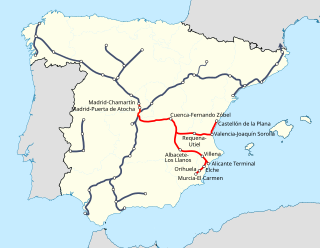
The Madrid–Levante high-speed network is a network of high-speed rail lines that connects Madrid with the Mediterranean coast of the Levante Region, specifically with Castilla-La Mancha, the Valencian Community and the Murcia Region autonomous communities.
Valencians are the native people of the Valencian Community, in eastern Spain. Legally, Valencians are the inhabitants of the community. Since 2006, the Valencian people are officially recognised in the Valencian Statute of Autonomy as a nationality "within the unity of the Spanish nation". The official languages of Valencia are Valencian and Spanish.

39°19′30.73″N0°57′5.01″W

Valencia is a province of Spain, in the central part of the autonomous Valencian Community. Of the province's over 2.5 million people (2018), one-third live in the capital, Valencia, which is also the capital of the autonomous community and the 3rd biggest city in Spain, with a metropolitan area of 2,522,383 people it is also one of the most populated cities of Southern Europe. There are 265 municipalities in the province.

The Alarcón Dam is a gravity dam on the upper course of the Júcar River. It is located 6 kilometres (3.7 mi) from Alarcón, in the province of Cuenca, in the autonomous community of Castilla-La Mancha, Spain.

Consuelo Mata Parreño is a Spanish archaeologist who specialises in Iberian material culture. She is currently the Director of the Department of Archaeology at the University of Valencia.
Alajú or alajuz is a Castilian cake originating in Cuenca in Spain. It is traditionally made with an almond base, roasted bread crumbs, spices, and honey. It is then covered with two wafers on the sides of the base. Almonds may be substituted with other nuts, such as pine nuts.
